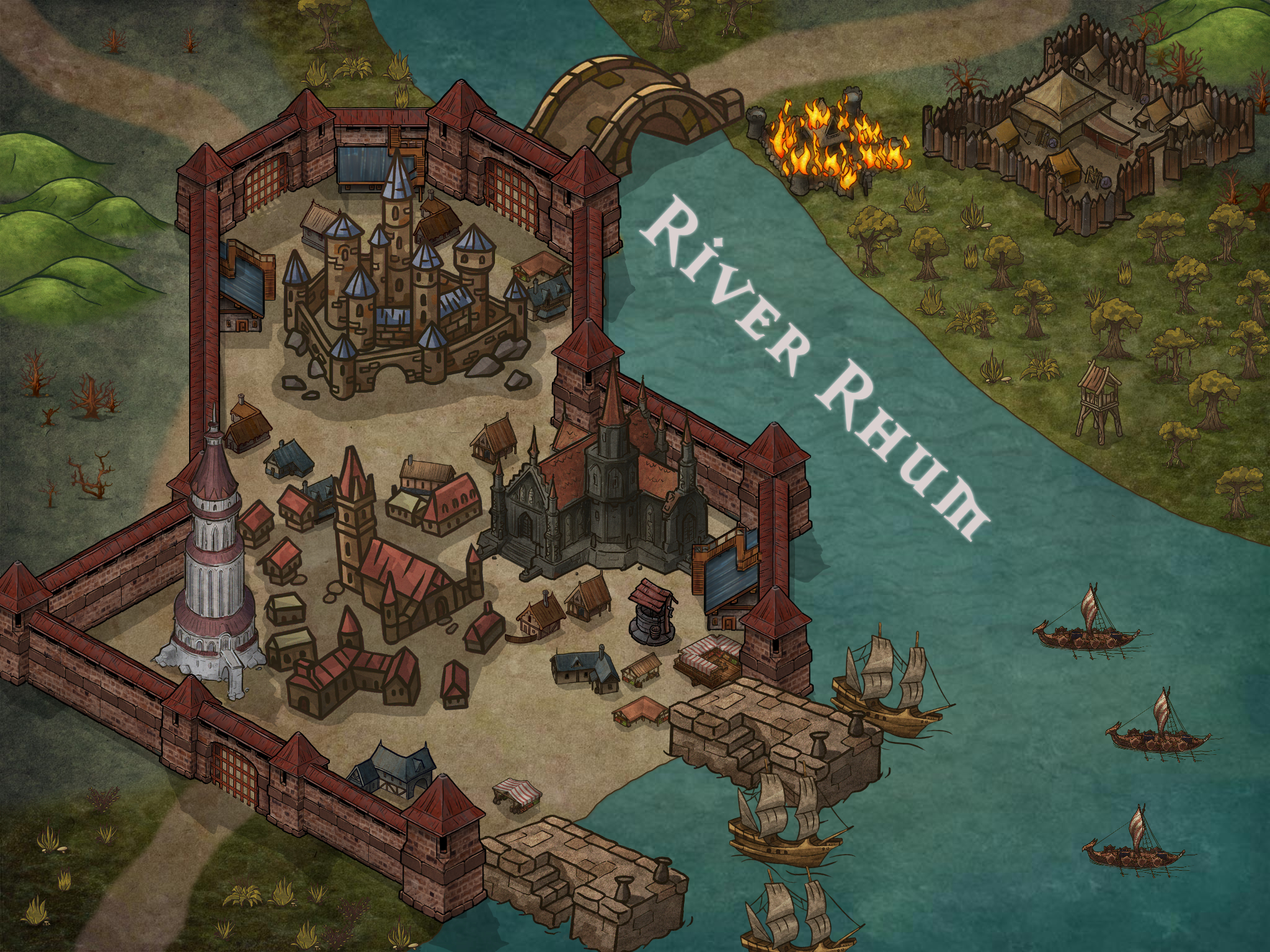The Siege of Rhuma
Far away, where sunshine never fails/
There lies that land, the saddest of tales./
The strong golden gates, now broken open wide/
In came the foes, rushing like a tide.
The Conflict
Prelude
The siege of Rhuma was preceded by a short battle to take the Marsh of Tulius, in which 3,000 Rhumnarian heavy infantry managed to prevent a Saxon advance from taking their defensive positions for a week, inflicting a speculated 4,000 casualties to the Saxons before being slaughtered to a man.
Deployment
The Rhumnarian defenders deployed to key defensive structures in an around the city of Rhuma while the Saxon advance was slowed at the Battle for the Tulian Marsh. Upon arriving, Saxon combat engineers began work on siege engines beyond archer and range while Saxon infantry deployed to take the Bridge of Octavius, which crosses the River Rhum.
Battlefield
Conditions
The battle had begun in the onset of winter, and this time of the year is particularly moist in that part of the world. As Rhumnarian civil engineers were prevented from manning the levies on the Eastern shore of the River Rhum, the mechanisms failed, and the Tulian Marsh was saturated, leaving the conditions for the Saxon camps waterlogged. As the siege dragged into Eloreth, the chill of winter set in in earnest, much of the ground in the marsh froze solid, leading to injuries within the camps, and hypothermia took many Saxon lives.
The Engagement
The siege began in earnest when Saxon light infantry charged the Octavian Bridge, attempting to overtake the defenders with a quick and overwhelming strike. This strategy won the Saxons control of the Eastern end of the bridge, but the defenders set fire to their fortifications to deprive the enemy of their use, and the Saxon advance was held off by the city's defenses. For the next month, neither side managed to gain ground against the other; the walls of Rhuma stood firm, and the Saxons were too numerous for the defenders to assault. During this time, Südhlander forces came up from the South and began plundering the countryside outside the Western flank of the city, but did not assail the walls themselves.
After two months had passed, the city had suffered much internal damage, and fires were getting harder to suppress. This is when the 14th Legion, with auxiliary forces, arrived. The Lindish auxiliaries of the 14th Legion, led by Evan the Bull, charged through Saxon lines, cutting a path to the bridge to enter the city, bringing supplies that the legion had plundered from invasions into Saxon territory.
A week from this event, Saxons managed to breech the city from the harbor, beginning a week of close quarters urban combat. During those last days of the siege, civilians and wounded were evacuated from the city; Baraki auxiliary forces kept Südhlander raiders at bay while the people of Rhuma made it to the countryside. On the final day of the siege, Evan the Bull was said to have carried out fifty-five Rhumnarian soldiers, before succumbing to his wounds. The siege finally ended on that day, the 31st of Finoreth, which marks the theme for the next thousand years; the city was burned, the Saxons only sparing the Cathedral of St. Urbanus II and the Tower of the Magi. The Imperial Palace was plundered and then burned to the ground, and the Saxons left the city on the 3rd day of the new year.
Outcome
The destruction of the city of Rhuma
Aftermath
End of the Rhumnarian Empire
Deposition of the Iulian Imperial Dynasty
Deposition of the Iulian Imperial Dynasty
Historical Significance
Legacy
In Saxon culture, the victory is played up as the great turning point in their history; after this victory, the Saxons rose to take a majority of former Imperial land, only failing to subdue Rhäumnaria and Barakum.
To those loyal to Rhuma, the failure of the Empire is seen as the greatest tragedy to befall the world, as the peace of Anglëa was permanently shattered; the Saxons proved incapbale of maintaining the borders they now occupied, and their empire fractured when the Lindoners declared independence and the dynasty of Sack split the land between multiple heirs.
To those loyal to Rhuma, the failure of the Empire is seen as the greatest tragedy to befall the world, as the peace of Anglëa was permanently shattered; the Saxons proved incapbale of maintaining the borders they now occupied, and their empire fractured when the Lindoners declared independence and the dynasty of Sack split the land between multiple heirs.
Conflict Type
Siege
Battlefield Type
Urban
Start Date
16th of Tekoreth, Age of Silence 1000
Ending Date
31st of Finoreth, Age of Silence 1000
Conflict Result
Pyrrhic Saxon Victory
Belligerents
The Kingdom of Sack (and allies)
The Rhumnarian Empire
Strength
100,000 Saxons
20,000 Light Cavalry
10,000 Heavy Cavalry
66,000 Infantry
4,000 Combat Engineers
20,000 Light Cavalry
10,000 Heavy Cavalry
66,000 Infantry
4,000 Combat Engineers
53,000 Südhlanders
40,000 Light Cavalry
10,000 Light Infantry
3,000 Combat Engineers
40,000 Light Cavalry
10,000 Light Infantry
3,000 Combat Engineers
12,000 Lindoners
10,000 Light Infantry
2,000 Combat Engineers
10,000 Light Infantry
2,000 Combat Engineers
70,000 Rhumnarians
50,000 Heavy Infantry
5,000 Heavy Cavalry
6,000 Light Cavalry
5,000 Combat Engineers
4,000 Palace Guards
50,000 Heavy Infantry
5,000 Heavy Cavalry
6,000 Light Cavalry
5,000 Combat Engineers
4,000 Palace Guards
10,000 Auxiliary Soldiers
4,000 Lindish Light Infantry
2,000 Saxon Light Cavalry
3,000 Südhlander Light Cavalry
2,000 Baraki Heavy Cavalry
3,000 Baraki Heavy and Light Infantry
4,000 Lindish Light Infantry
2,000 Saxon Light Cavalry
3,000 Südhlander Light Cavalry
2,000 Baraki Heavy Cavalry
3,000 Baraki Heavy and Light Infantry
Casualties
62,500 Saxons
10,300 Südhlanders
5,000 Lindoners
10,300 Südhlanders
5,000 Lindoners
50,820 Rhumnarians
3,850 Lindish Auxiliaries
2,000 Saxon Auxiliaries
3,000 Südhlander Auxiliaries
4,512 Baraki Auxiliaries
3,850 Lindish Auxiliaries
2,000 Saxon Auxiliaries
3,000 Südhlander Auxiliaries
4,512 Baraki Auxiliaries
Objectives
Take the city of Rhuma
Defend the city of Rhuma
Evacuate civilians and Imperial family
Evacuate civilians and Imperial family





Comments